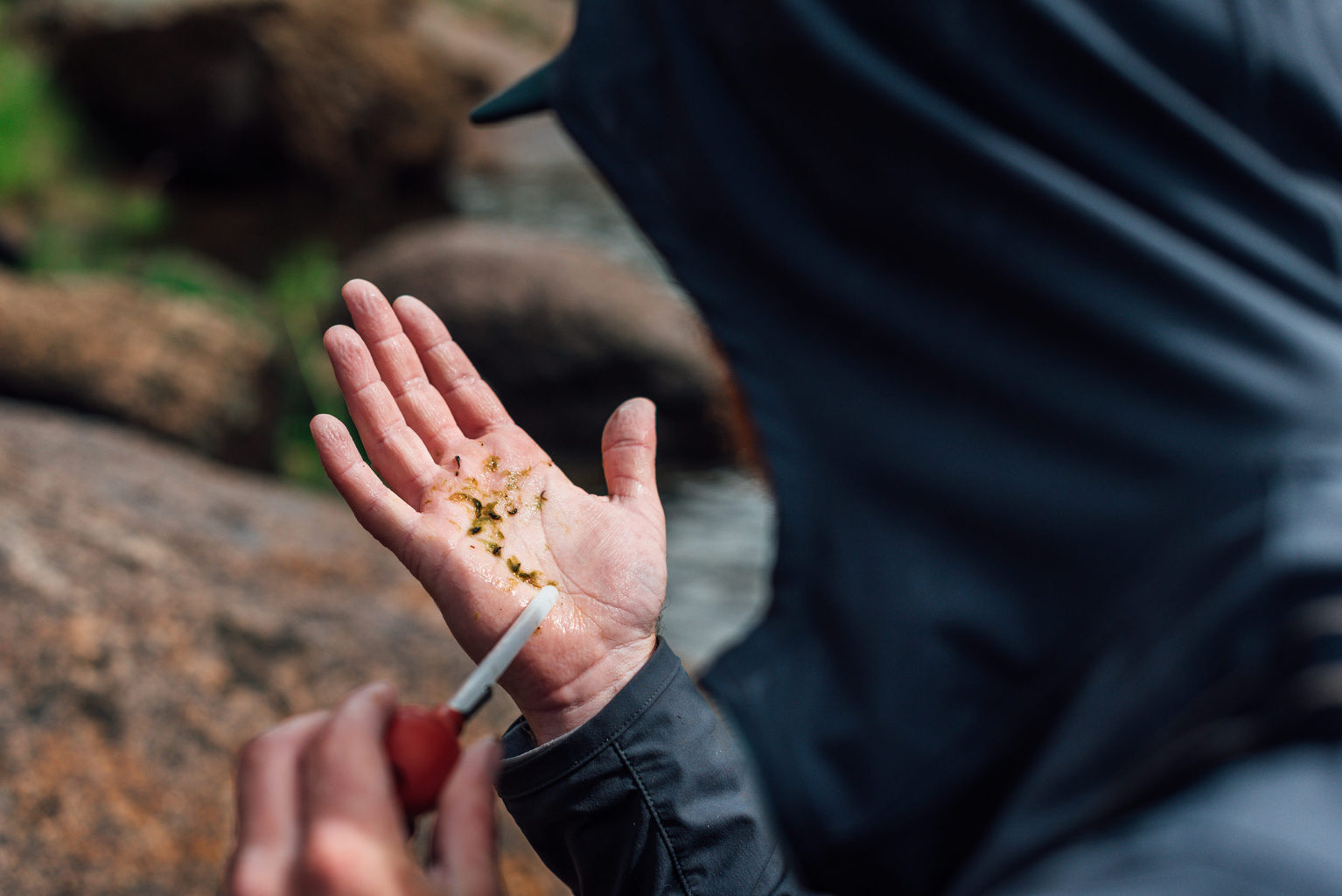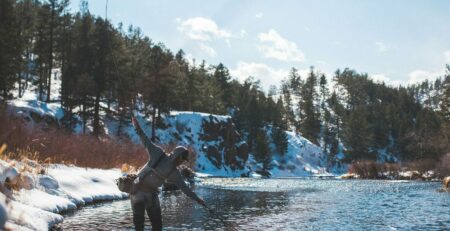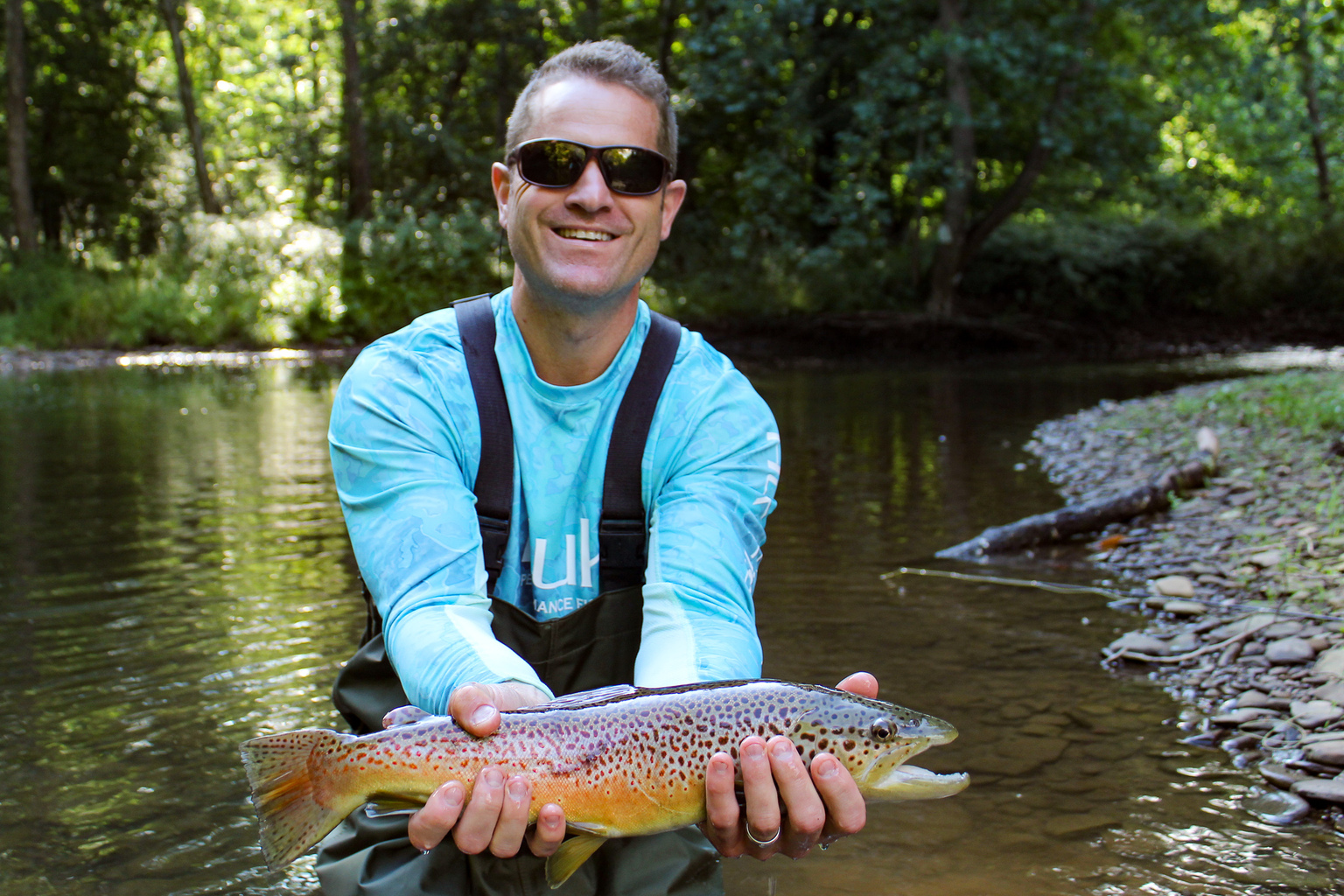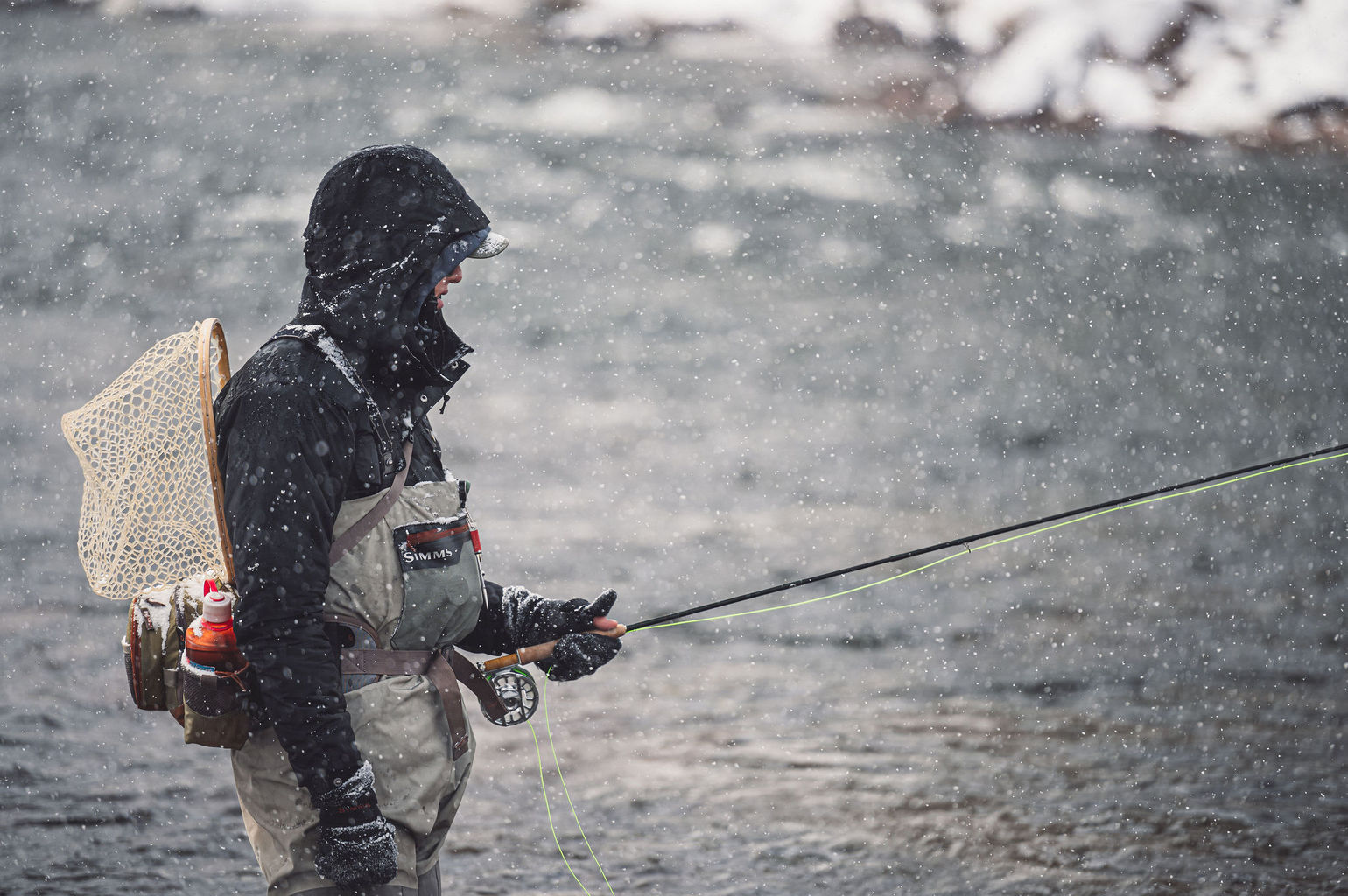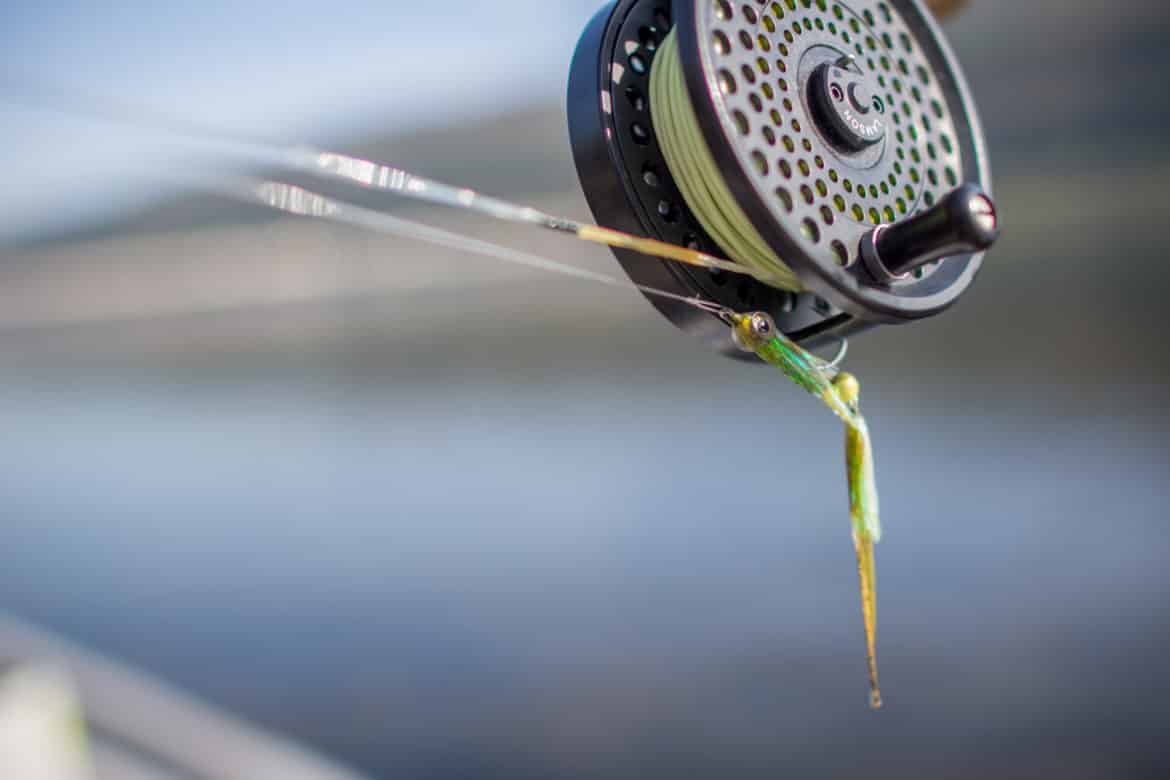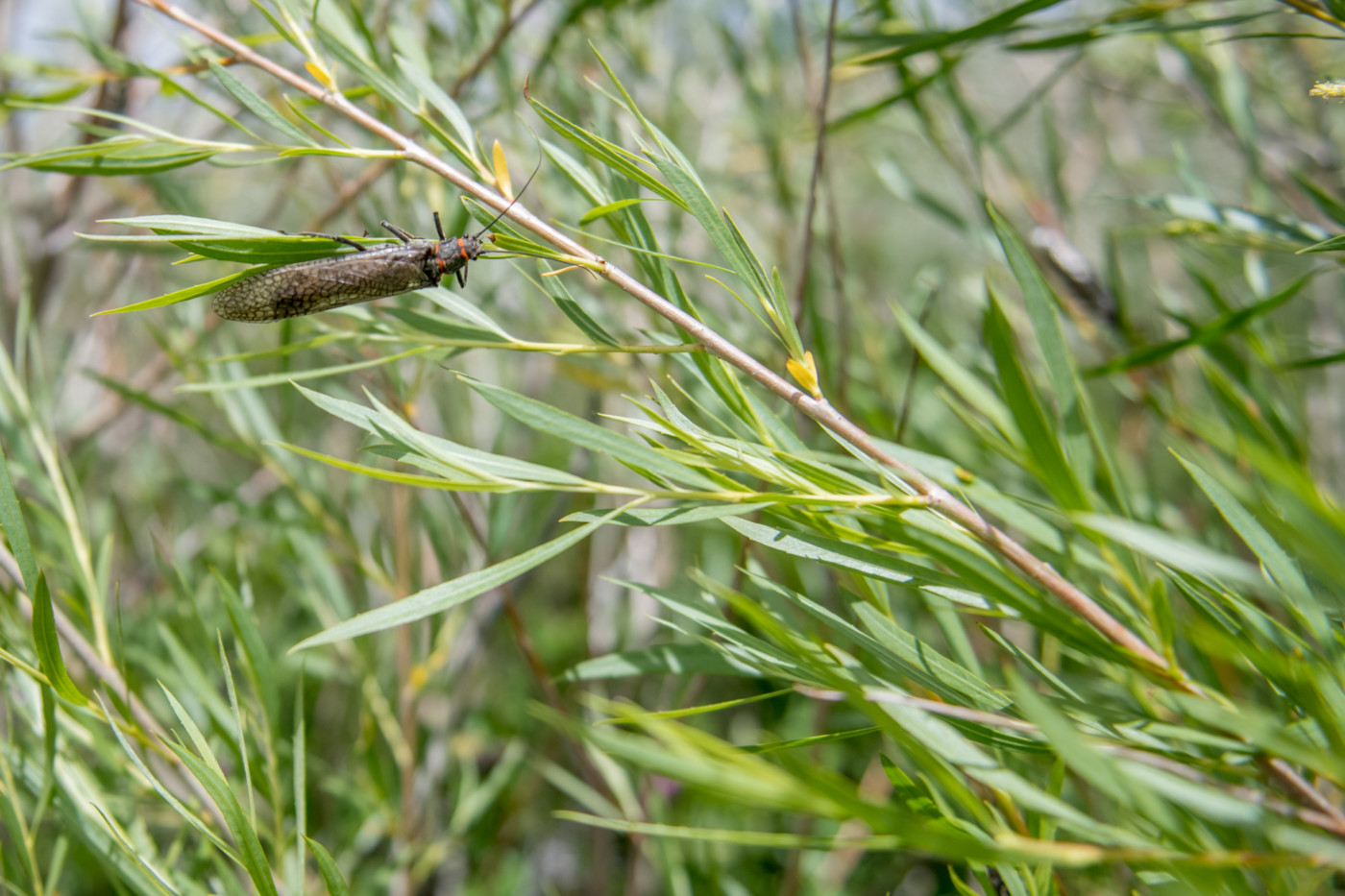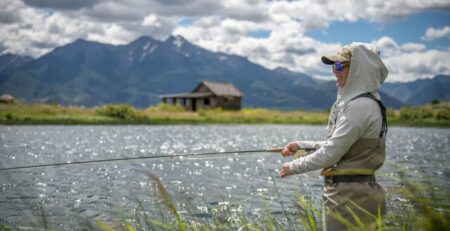How To Fly Fish for Bass: Fly Fishing Guide to America’s Number One Gamefish
Bass are the most sought after game fish in North America. No matter what state you live in, there is a high likelihood that there is a place to fish for bass near you. Although most people imagine bass fishing with glittery fiberglass bass boats, large bait casting reels, and huge plastic, and scented baits, both large and small mouth bass are excellent targets for anglers on a fly rod.
Like trout, they occupy beautiful and rugged places. Catching bass on the fly is exciting. Bass fight hard, often going airborne, and they eat top water poppers with reckless abandon. Large and smallmouth bass are ideal targets for fly anglers both young and old.
Table of contents
In this article, we will discuss how to catch bass with the proper preparation, tactics, and rigs that are needed to successfully target North America’s most popular game fish, the largemouth and smallmouth bass.

Understanding Bass Behavior
Largemouth and smallmouth bass are territorial, aggressive, and downright mean. Taxonomically, speaking, largemouth and smallmouth are oversized sunfish, and as such, they are voracious eaters. If bass were the size of sharks, then thousands and thousands of people would be eaten every year in lakes, rivers, and streams across North America.
Largemouth and smallmouth bass are hardy fish whose distribution can be found throughout the United States and North America. North, East, South, and West, they occupy both cold and warm water fisheries. Dirty or clean water, it doesn’t matter. In many of their aquatic ecosystems, they are the top predators. Like all animals, their lives revolve around survival and reproduction.
Bass Spawn in the springtime. Depending on the geographic latitude, this can happen anywhere from February to June. The further South you are and closer to the equator, the earlier the spawn will happen. As you move North, the spawning season becomes later as the colder water of Northern latitudes delays this portion of the life cycle.
Much like trout, bass will create spawning beds by using their tails to move grass, sand, debris, and vegetation from a spawning area. The female will lay her eggs in the spawning bed and the male bass will fertilize them. Once the eggs have been laid and hatch, the female bass leaves, and the male bass will sit on the bed and protect the fry from other predators. During the spawn and pre-spawn phase of the lifecycle, bass becomes extremely aggressive and territorial. Flies thrown into beds will often elicit a territorial strike or defensive strike. This is the best time of the year to catch a trophy size fish.

Pre Spawn Behavior
Smallmouth and largemouth bass spend most of their time in the winter in deeper areas of lakes and rivers. As the water begins to warm, Largemouth and smallmouth bass will move from the deep parts of rivers and lakes and into shallow water staging areas.
Their caloric demands for breeding increase in preparation for laying eggs. Bass become hyper aggressive and will strike baits from both reactionary strikes and out of the necessity for food. This is an excellent time for fly fishing for bass. Presenting flies in shallow water makes it easier for fly anglers to target bass on a fly. Pre spawn bass fishing areas are usually well known, as bass will return to the same areas year after year in preparation for laying eggs.
Largemouth and smallmouth Staging Areas
Often smallmouth and largemouth will stage in grass-lines, around structures, shelfs, and ledges. These are usually areas that are next to or close to their deep winter haunts.
Natural funnels like road beds, points, and creeks will often be used to move back and forth between their winter and spring nesting areas. Anglers should target bass in these natural channels, as fish are usually concentrated in these areas with great density.
Weather Effects The Pre Spawn
Weather plays a major role in early spring bass behavior. Smallmouth and largemouth bass during this time of year will move between deep water and shallow pre-spawn areas.
Cold fronts will periodically push through in the early spring. This can create major temperature swings which will push bass out of the shallow water pre spawn staging areas and back into deep water. For a fly angler, it is difficult to effectively fish flies really deep in comparison to conventional bass fisherman.
Fly fishing the pre-spawn stage is best when there has been longer periods of warm weather. Savvy anglers who know their lakes and rivers well, can target fish moving back and forth between staging areas during these temperature swings. That being said, long bouts of early spring warm spells give fly fishers the best opportunity for a trophy largemouth bass.
Largemouth Bass and Smallmouth Bass Bed Behavior
Once a largemouth or smallmouth bass finds a suitable place to lay her eggs. She will clear the debris with her tail and lay her eggs. The female bass will sit on the nest for a relatively short time. Once she lays her eggs she will leave. This short nesting window is the time of the year that she is at her absolute heaviest. It is this moment in the spawn, that a fly angler could catch their biggest fish of the year.
The male will accompany her during this time. His job is to help her deposit the eggs in the nest and fertilize them. As the eggs leave the female, they can often become stuck. The male bass will gently knock up against her to knock the eggs free. Once the eggs are laid and the female is “spawned out”, she will leave and the smaller male sits on the nest and protects it from would be predators: crayfish, other baitfish, bass, and even lizards are all worthy adversaries looking to steal eggs and freshly hatched fry.

Where to Fly Fish for Bass
Bass can be found in lakes, rivers, and streams throughout North America. Generally speaking, bass love cover and structure. Ambush points are the primary areas that these aggressive predators will occupy: log jams, fallen trees, deep holes, grass beds, lily pads, sunken rock pile, ledges, seam lines and overhanging banks are all places that will hold large and smallmouth bass.
Any place that affords bass protection from birds of prey, and allows them to ambush unsuspecting food items are prime lies to consider when choosing where to fly fish for large or small mouth bass.
Fly Fishing For Bass In Rivers
Many fly fishers that pursue trout will also feel comfortable pursuing bass. In river ecosystems, bass hold in many of the same places that trout do. Log jams offer protection from predators and ample opportunities to attack unsuspecting prey. Drop offs and shelves with current flowing over the drop offs are excellent places to find bass waiting for food to be brought to them. Overhanging bushes and undercut banks provide feeding opportunities for bass, as grasshoppers, mice, and other terrestrial food items fall into the river.
For fly anglers, early spring is arguably the best bass fishing of the year in both rivers and lakes. Fly fishing for bass in early spring often allows fly fishers to take their largest bass on a fly rod in river systems.
There are two reasons for this: First, bass are preparing for the spawn and are actively looking for an increase in calories. Second, in river systems, shallow water becomes warm first. As a result, bait fish will move into the shallow water and bass will follow the bait fish in search of food. This affords fly anglers, ample opportunities to catch bass in shallow water.

Fly Fishing For Bass In Lakes
In lakes, bass will often be found in many of the same places as they are in rivers. The difference between lakes and rivers is that much of the structure that bass enjoy is usually hidden in deeper water and out of eyesight. This means fly anglers have to use visual surface cues and topographical maps to locate potential holding areas.
In lakes, boat docks are excellent targets. They offer man made structures for bass. Not all boat docks are created equal. Focus your attention on boat docks that are on points, and are also built further out from the shore. These two clues help bass anglers pick and choose the best docks to fish. These docks are great targets and usually hold lots of fish. This is because boat docks that meet the above criteria usually indicate that they are built on natural submerged lake points. As we mentioned above, points in lakes are excellent ambush sites and act as natural funnels for food as well as easy access to deeper water. Identifying underwater features is helpful too.
Fly fishers who study topographic maps prior to fishing for bass will have an advantage when fly fishing for bass on lakes. Topographic maps make natural funnels easy to identify even before anglers ever set eyes on a body of water. It is easy to identify where these lake features and make educated guesses on where bass will be. Studying maps and looking for creek beds, old roads, submerged shelves, changes in bottom lake floor structure (mud bottom to gravel bottom), and even old buildings will drastically reduce the lake fishing learning curve.
Show Now: Bass Flies & Streamers
Primary Food Sourceso For Bass
Food items for bass vary. Bass feed on almost any other living creature that they can fit inside their mouths. Their main source of food is other fish and crayfish.
However, large and smallmouth bass will eat lizards, frogs, mice, hellgrammites, small ducks, and even snakes if they are given the opportunity. This creates many exciting fly fishing opportunities for the angler willing to throw large bass poppers and streamers. Having all the equipment with the correct rod, fly reel, leader, and bass flies is critical to being successful on the water.

Fly Fishing Rigs For Bass
Choosing the correct fly tackle for bass fishing is important because fly fishing for bass often requires presenting heavier streamers or large popper flies tight to structure, close to the bank, or to deep water in lakes. This is not always the case, as fly fishing for bass can also be done on lighter rods for anglers who want to try bass fishing for the first time but aren’t fully committed to the species.
Crossover Rods
Many anglers who choose to dabble in both trout and bass fly fishing could choose lighter rods, such as 5 or 6 weight fly rods. Your standard 6 weight trout rod will work very well. This is an ideal rod for fly fishing in smaller streams and creeks. Smaller flies, like small bass poppers, crayfish fly patterns, leech patterns, and small rabbit fur streamers can be fished effectively on lighter fly rods. Even trout anglers’ favorite flies like Pat’s Rubber Legs, is effective at catching smallmouth bass. Lighter rods are a good option if you are only going to buy one rod but would like to fly fish for both bass and trout. For the more serious fly fisher, rod weight matters. Choosing a 7 or 8-weight rod, with a fast tip is an ideal choice for targeting larger fish and throwing large fly patterns, weighted flies, and heavier sinking lines tight to structure with greater accuracy.
Big fish eat big flies. Sizing up in fly rods with a heavier weight rod with a fast action tip gives fly fishermen the ability to throw large deer hair poppers, large frog patterns, articulated streamers, and the famous Game Changer streamer fly. This fly imitates large bait fish in the same manner that hard bodied conventional swim baits do. The fast tip fly rod gives the fly fisherman the ability to present these larger baits with greater accuracy to banks, log jams, and other ambush hiding areas. In addition, it allows the angler to aggressively set the hook and drive the fly into a bass’ bony mouth.
Anglers can use a weight forward floating fly line for most situations. Floating lines are ideal for surface flies, or presenting shallow water Clouser Minnows, Wooly Buggers, and other streamer flies. A sink tip line is ideal for deeper lakes or swift moving rivers. Sink tip line presents the flies to fish holding on around the structure in deeper water.
Heavier Leaders
The proper leader is critical for success. Choose a shorter leader in the 6 to 7.5 ft range. Heavy leader material in the 12-20 pound test is important when casting large bass flies. The increased thickness of the fly leader will help turn the fly over and present heavier flies with greater accuracy. In addition, heavier tippet and leader material is abrasion resistant, which is important when fly fishing in heavy cover. This will result in better presentation and fewer break offs when targeting larger sized bass in the 3 to 10 lbs range.
Invest In A Good Drag
Bass are hearty game fish that fight much harder than your average trout. Choose a fly reel to compliment a fast action fly rod with an adjustable drag system. A reel with a solid disc drag and spooled with plenty of backing and a floating line is a must have when fly fishing for bass. An adjustable drag will make a huge difference when fighting big bass in heavy cover. A good drag system will allow anglers to power fish away from the structure and protect your leader from breaking.

Fly Fishing Flies For Bass Fishing
Of course, choosing the correct flies to entice bass is the last piece of the puzzle when it comes to fly fishing for bass. There are many options here, and choosing the right flies is often what you have the most confidence in. We will discuss some general patterns that work well across various situations and water bodies.
Trout Flies That Also Work For Bass
If you are a trout fisherman that is wanting to dabble in fly fishing for bass with a lighter rod in smaller streams and creeks, then traditional trout flies and streamers will work just fine: Wooly Buggers, Dave’s Hopper, small popper patterns, small crayfish patterns, shallow Closer Minnows, micro foam poppers, Muddler Minnows, and even a leech pattern will catch plenty of bass on a fly rod.
Big Bass Eat Big Flies
For anglers that want to target bigger sized large and small mouth bass, then larger streamer patterns and huge foam or deer hair popper flies are going to be your best choices for targeting fish in the 3 plus pound size range.
Show Now: Bass Flies & Streamers

Articulated Flies
These lager flies and fly rod setups in the 7 to 8 weight fly rod range are straddling the line between fresh and saltwater fly fishing rigs. With a properly setup 8 weight rod, fly fisherman can throw large flies like Chochlett’s Game Changer. The Game Changer is the closet bait that fly anglers have to cast large swimbaits like their conventional bass fishing brethren. Swim baits are large articulated lures that swim like real fish and imitate other bass, perch, shad, or even rats. Big fish eat big baits, and fishing a large Game Changer fly that is 5’-8” long is hard work. Often produces long periods of fishless days. However, all it takes is one fish, and it is usually a trophy.
Other large flies that are effective bass patterns are the boogie man streamer, Sherik’s Magnum Rattlestrip, the Lunchable Streamer, the Sex Dungeon, and the Meat Whistle are all great bass flies. These large fly patterns move and push water sending vibrations to fish waiting to ambush prey. Larger fly patterns fished slowly through murky water can be effective patterns in both lakes and streams. An orange or yellow Sex Dungeon is an awesome fly for rivers and lakes that have large crayfish and sunfish populations. It is an excellent cross over pattern that covers both species of forage.
Large deer hair poppers or foam poppers tied with the famous howitzer head are effective for targeting big fish in both lakes and streams. The Swimming Baitfish and diving baitfish patterns are big deer hair poppers that make lots of commotion when aggressively stripped. This imitates baitfish struggling at the surface in shallow water.
Large plastic jigs with heavily weighted bullet weights are often used by conventional bass anglers. This is referred to as power fishing. These large baits are thrown into thick cover and are effective for targeting bass on nests. While fly anglers are not able to use heavy dad weights, bass flies tied on large jig hooks with barbell eyes are an excellent alternative that allows fly anglers to fish many of the same areas that their conventional angling counter parts are able fish. In addition, these fly patterns can be tied with rabbit fur and incorporate a weed guard so they don’t snag on brush or thick vegetation.
A Skulzilla or Silly Wiggler are great examples of fly patterns that imitate conventional bass fishing baits. These heavily weighted flies can be thrown into cover, or directly into spawning beds. Both flies give anglers the ability to fish flies deep and jig them in a way that imitates a rubber jig or plastic worm.
Recommended Reading: Articulated And Underestimated: Fly Fishing For Large Trout And Bass

Effective Fly Fishing Retrieval Techniques for Smallmouth and Largemouth Bass
There are many effective fly fishing retrieval methods when fishing for large mouth bass. Depending on what prey you are imitating, or water conditions, varying the retrieve rate and speed can trigger strikes.
For murky water, a slower retrieval is helpful. Fish need to locate the fly in order to eat it. Flies that push water, undulate in the current of the river, and get to the proper depth are effective at mimicking injured baitfish struggling in the current of the river. Oftentimes times bass will attack injured fish out of instinct. A slowly fished streamer fly fished in the correct manner can catch fish on days even when the fishing is slow.
Multi-Jointed Fly Patterns
Articulated patterns are an excellent choice when fishing either utilizing slow strips or a fast retrieve technique. When fishing articulated streamers fast, strip them in with quick short strips or long fast strips. In addition, an effective technique that often triggers strikes and gets a bass’ attention is to strip an articulated fly and aggressively wiggle the tip of the fly rod at the same time. This works really well with the Feather Changer, Game Changer, or Sex Dungeon type flies. The rod tip imitates life like action.
Wiggling the rod tip while stripping in articulated patterns will impart action that is extremely similar to an injured or dying fish. Many of the strikes that result from this type of streamer fishing are the result of a territorial or reaction strike. These same strikes are similar to when a female is protecting her nest from would be raiders. This is an effective technique to use when fish aren’t actively feeding.
For fishing poppers, slow, fast, soft, and hard strips all have their place when fishing these buoyant flies. No matter what method you choose, the initial presentation is important when fishing bass poppers.
Show Now: Popper Flies
Play Dead Bass Popper Retrieval
Bass popper patterns imitate terrestrial and aquatic vertebrae that have haphazardly fallen in the water. The most common of these are frogs. However, rats, grasshoppers, snakes, and even ducks are all food sources for big bass. When these food sources fall from the bank into the water, they make a hard impact. Momentarily stunned from suddenly going from dry land to the river or lake’s surface. Their natural reaction is to freeze, not moving for a few seconds before struggling to make their way back to the bank of the river. Imitating this with a popper fly gives a life like presentation that will often fool fish into striking the fly aggressively.
Get Closer To The Bank
When presenting bass popper flies, casting as tight to the bank as possible will often help you be successful in catching bass waiting near the banks for unsuspecting prey. The fly should impact the water hard. This initial contact with the water is a calling card to all would be predators in the area. Let the fly sit motionless on the surface of the water for 3-5 seconds and then start your retrieve.
Depending on what prey you are trying to imitate, short and long aggressive strips will move lots of water and make a lot of noise. This retrieve can be effective when fishing in dirty water or when the bite is slow. An aggressive retrieve can initiate a reactionary strike. In gin clear water, a slower more subtle presentation will often do the trick. This can even be as subtle as casting a popper fly onto the surface of the water and leaving it motionless for long periods of time. The most important thing to remember is to vary the retrieve and try different speeds and lengths of strips.

Fly Fishing With Divers
Divers are a more subtle and versatile topwater option. A diver is a minnow-shaped fly with a convex head. The floating head is often made from light foam with a very small weight. When pulled, the diver slides underwater. The action imitates the erratic movements of wounded baitfish. The diver appeals to fish that are actively feeding on minnows or other small baitfish.
Divers are more versatile than poppers. They are perhaps the best choice of any fly to cover large areas of water. Many anglers use divers to scout out new bodies of water, since they can be cast long distances and retrieved rapidly. The diver can be retrieved in various ways, but it is common to simply strip long pulls of line consecutively while allowing a second for the diver to float in between. Some anglers compare the action and use of the diver as the fly fishing equivalent of the age-old in-line spinner lure. Both move quickly through the water, imitating a baitfish near, but below, the surface.
Divers are usually the best choice to match patterns when bait fish are schooling. Predatory fish stalk the schools, looking for a wobbly, erratic fish that is sick or injured. Additionally, we know that fish change patterns during the day. During warm weather, baitfish may seek cooler temperatures in a deeper area of creek channel. The diver will work in this circumstance, while poppers cannot be used.
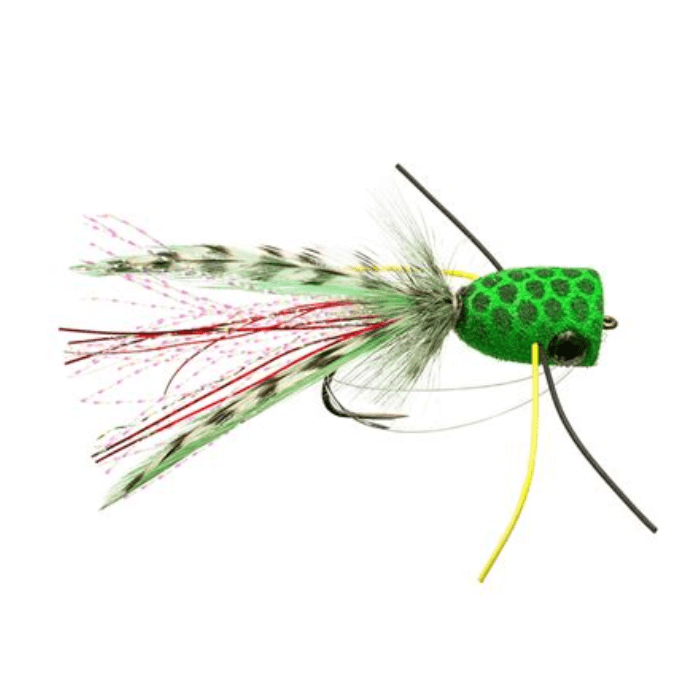
Fly Fishing With Poppers
The popper is one of the oldest lures that exists. Many anglers also think it is the most exciting fly to use. Poppers are tied with a compact head that is round or square in shape. The head has a concave or lipped cup shape which is designed to catch water as it is pulled across the surface, making a characteristic “pop” sound that gives the fly its name. The popper is exciting and productive, but it is not a versatile offering.
Poppers land with a noisy commotion on the cast, which gets the attention of aggressive fish. On the retrieve, the angler pulls a few inches of line causing the characteristic gurgling sound. Poppers are usually fished slowly, with a few pops followed by a still period. This pattern imitates prey such as a dying baitfish, a frog moving across the surface, or any other animal in peril on the top of the water. The popper tempts fish that are actively feeding but also provokes strikes from instinct or territoriality.
The popper is the best choice in certain circumstances. This fly type is most popular for largemouth bass and panfish. During the spring, these species often aggressively chase noisy flies on the surface as they feed on insects and small baitfish. A small popper is a perfect choice for bluegills feeding on beetles or caterpillars falling from overhangs or bass patrolling the shallows. Poppers work well in dark conditions such as first thing in the morning or as dusk turns to evening. The noisy presentation provokes strikes when sight feeding is not possible.
Poppers are also the ultimate choice when the goal is simply excitement! Nothing gets the heart racing like an explosive bass strike on a popper, with the entire fish leaping up from the surface in a spray of water.
Fly Fishing Made Easy 👍
Our Quarterly Fly Club ships 1,000’s of flies to anglers all across the United States. Receive curated fly assortments selected for the season with in-depth articles on how to fish them. Great for beginners to learn and for intermediates to discover new flies.




